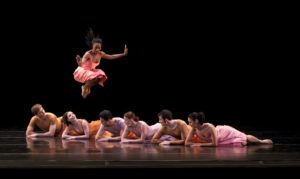I wrote an appreciation of Paul Taylor for the online edition of today’s Wall Street Journal. Here’s an excerpt.
* * *
 Paul Taylor, who died on Wednesday at the age of 88, was the dean of American choreographers—though that’s a strangely stiff word to use about a master of modern dance who was in private life far from formal. Even when he joined the members of the Paul Taylor Dance Company to take a bow at evening’s end, I can’t recall ever seeing him wearing anything but casual clothes, just as he usually spoke of his work, at least to journalists, in the lightest of tones. Only once did he break that rule in my hearing, when I asked him in an interview whether he thought his dances would survive him. He sat in silence for a moment, then replied, “I don’t know if they’ll last. I try to make them to last. They’re not made to be seen one time.” Nor were they…
Paul Taylor, who died on Wednesday at the age of 88, was the dean of American choreographers—though that’s a strangely stiff word to use about a master of modern dance who was in private life far from formal. Even when he joined the members of the Paul Taylor Dance Company to take a bow at evening’s end, I can’t recall ever seeing him wearing anything but casual clothes, just as he usually spoke of his work, at least to journalists, in the lightest of tones. Only once did he break that rule in my hearing, when I asked him in an interview whether he thought his dances would survive him. He sat in silence for a moment, then replied, “I don’t know if they’ll last. I try to make them to last. They’re not made to be seen one time.” Nor were they…
Part of the durability of his dances arises from the subtlety with which they dramatize the opposing polarities of man’s divided self— male/female, dark/light, primitive/civilized, innocent/knowing—and set them in motion on stage, there to collide with one another, sometimes comically and sometimes fatally. Rarely does a Taylor dance express an emotion without also hinting at its inversion. This dualism is part of what makes his work at once ambiguous and accessible…
Early in my dancegoing life, I took a willing but initially unenthusiastic cabaret singer to a performance of “Esplanade,” Mr. Taylor’s signature piece, set to the music of Bach. When the curtain came down, I asked her what she thought. It wouldn’t be right to say she was speechless, since she was doing her best to reply, but she couldn’t get a sentence going: She was so stunned that all she could do was stammer. I’ve never seen anyone else react so viscerally to their first viewing of a Taylor dance, but more than a few of my friends have come pretty close.
 What is it about Mr. Taylor’s work that inspires such enthusiasm? When it comes to “Esplanade,” the answer is self-evident: I don’t know another modern dance that speaks to the viewer with such immediacy and emotional openness. Yet the extroversion of “Esplanade” conceals the same heart of darkness that beats away in most of his other dances. The first time you see it, you’re left with an indelible mental image of dancers striding, flying, even sliding across the stage—but on second and third viewing, these pictures gradually give way to the remembered vision of a mysteriously androgynous, seemingly untouchable woman, searching in vain for a place in the indifferent world….
What is it about Mr. Taylor’s work that inspires such enthusiasm? When it comes to “Esplanade,” the answer is self-evident: I don’t know another modern dance that speaks to the viewer with such immediacy and emotional openness. Yet the extroversion of “Esplanade” conceals the same heart of darkness that beats away in most of his other dances. The first time you see it, you’re left with an indelible mental image of dancers striding, flying, even sliding across the stage—but on second and third viewing, these pictures gradually give way to the remembered vision of a mysteriously androgynous, seemingly untouchable woman, searching in vain for a place in the indifferent world….
* * *
Read the whole thing here.
The second section of Paul Taylor’s Explanade, performed by the original cast and originally shown on PBS’ Dance in America in 1978. The score is the slow movement of Bach’s E Major Violin Concerto:
